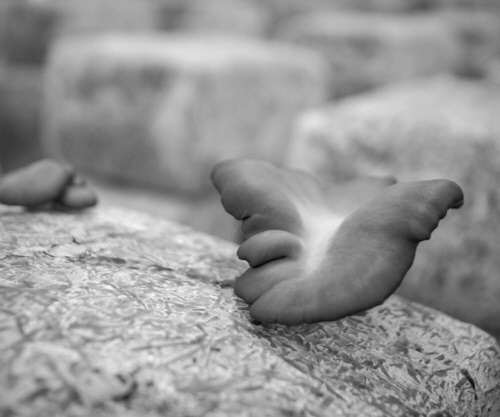About 20 years ago cultivation of mushrooms was introduced in Terralba, mainly due to active participation of a public organisation called E.R.S.A.T. Sardegna whose purpose is to help agriculture in Sardinia. In fact, cultivation of mushrooms was tried and assistance was given in order to educate potential mushroom growers. The first trial was done at a small farm in Terralba drawing interest from many agriculturalists who were growing vegetables in greenhouses and several of them turned to growing mushrooms in greenhouses instead.
We went to a region near Terralba in order to visit Giancarlo Sesuru and his wife who kindly showed us the greenhouses in which they are cultivating oyster mushroom (Pleurotus Ostreatus)so called because of its shape. The substrate on which the mushrooms grow is prepared with amongst other things hay and corncobs. After having been pasteurised, mycelium (the vegetative part of a mushroom) is injected into the substrate. Afterwards the substrate is inserted into bags of polyethylene by means of a machine and the bags are perforated with thumb-sized holes through which the mushrooms can pass when they are growing, resulting in a prism-shaped block weighing about 25 kg.
The blocks are transported to Giancarlo who put them in greenhouses where they are protected from the sun and maintained at constant temperature and humidity by means of large fans which draw out hot air. At the same time the air passes a panel filled with water which cools the greenhouse and increases the humidity at the same time.
In order to cultivate mushrooms, it is necessary to recreate the conditions where they are growing in the wild, that is a mild climate, low light, high humidity and little carbon dioxide.
Giancarlo has been cultivating mushrooms for 30 years after having met professor Ferri (professor and director at the University of Bologna and a national expert on growing mushrooms).
Having entered one of the greenhouses of Giancarlo, we could see rows of blocks on the floor placed such that space was used in an optimal way.
The cultivation begins with a period of incubation lasting from 25 to 35 days during which the blocks expand and the mycelium invades all of the substrate transforming it into a white and compact mass. Ideally, the temperature inside the blocks should be 27-28°C during the incubation, else the growth rate will slow down.
Giancarlo had inserted thermometers into some of he blocks and he measured temperature together with the level of carbon dioxide and oxygen 10 times daily because it’s very important to keep these quantities under control, else the mushrooms may stop growing. Besides, the temperature of the mycelium has to avoid drops in temperature, else it may stop growing at all.
After the mushrooms have matured, they are harvested and put in a cool room, packaged and transported to various supermarkets in Sardinia.
Giancarlo also showed us another cultivation using the same type of mushroom, but in a greenhouse with no air conditioning. He explained that the controlled cultivation accelerates the growth of the mushrooms, while leaving everything to Mother Nature results in mushrooms with higher quality, but with slower growth rate.
After having harvested the mushrooms, the greenhouses and the air conditioning devices are cleaned and disinfected before a new cultivation can start.
The contents of the blocks are used as manure or for making bio-gas.
Having visited a mushroom producer was a new experience for us and we thank Giancarlo and his wife for their willingness to show us their mushroom farm.

